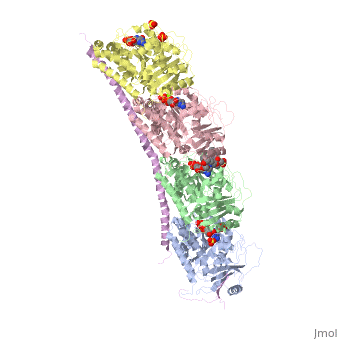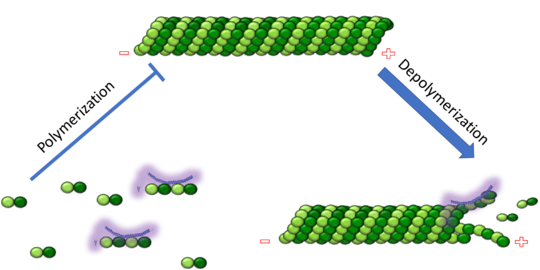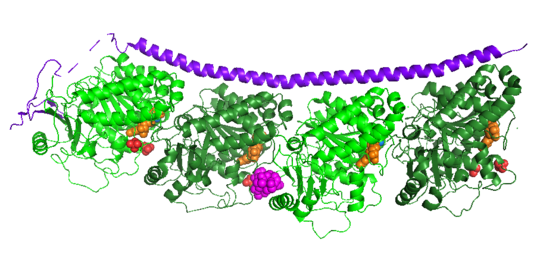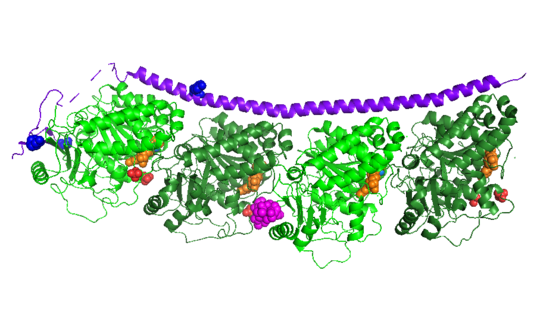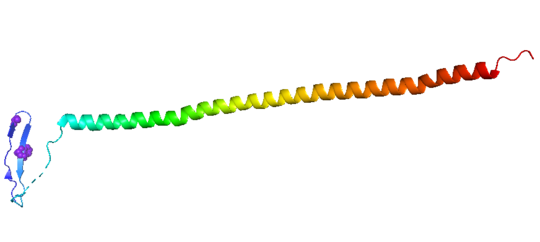User:Alisa Cario
From Proteopedia
- Full Real Name: Alisa Cario
- Position: Graduate Student
- Institution (NO ABBREVIATIONS): University of Vermont
- City, State/Province, Country: Burlington, VT USA
- Field of Expertise or Study: Creation of protopedia page for a class project. The class is Proteins 1 under Dr. Stephen Everse
Stathmin-4 bound to Tubulin stabilized with Vinblastin
4eb6
Introduction and BackgroundThe cytoskeleton brings structure to the cell, is integral in cell division, and aids in migration. One of the constitutive parts of the cytoskeleton are microtubules. Microtubules are polymerized from tubulin subunits that incorporate into a a ring structure linked together by lateral and vertical hydrogen bonds between heterodimers. Each tubulin subunit is made from a heterodimer of alpha and beta tubulin. Both alpha and beta tubulin are known to bind to GTP. However, only the beta subunit hydrolyzes GTP once incorporated into microtubules. The beta tubulin hydrolysis of GTP to GDP is known to destabilize microtubules. Microtubules have polarity where one end of microtubule, called the plus end, has more a greater affinity to add tubulin subunits than the other end, called the minus end. Microtubules are inherently dynamic, going through periods of depolymerization, known as catastrophe, and then return to polymerization, known as rescue. Microtubules can also go through a process called tread milling, where the length of the microtubule does not change but the rate of polymerization at the plus end equals the rate of depolymerization at the minus end. There are a number of microtubule associated proteins (MAPs) that are known to regulate the dynamics of microtubules. Some examples of this are KIF family kinesin motors, tau, MAP2 and stathmin.
FunctionStathmin, also known as oncoprotein 18 or metablastin, is a 19kDa microtubule associated protein known to destabilize microtubules. Stathmin's many names come from the fact that different labs discovered the protein during the same time. Stathmin is a cell cycle and developmentally regulated protein and is known to play a role in proliferation, differentiation and function of cells. ( ) Stathmin can bind to tubulin dimers to inhibit polymerization or it can bind to the microtubule to enhance the rate of catastrophe. This is shown in Figure XXX. Stathmin, shown in purple, can bind to tubulin heterodimers or microtubules , shown in green.
Migration The cytoskeleton is a vital part of cell migration. The leading edge is driven by actin polymerization. However, microtubules are needed to retract from the trailing edge to move the cell forward. Stathmin is thought to have a similar role in migration, allowing to microtubules to depolymerize to aid in movement. Stathmin is part of the integrin alpha5 beta1/FAK/ ERK pathway. "Differentiation" Stathmin expression is regulated during stages of development. It is regulated in early and late embryogenesis. It is also regulated in differentiating muscle cells, T lymphocytes, and oligodendryocytes. IsoformsThere are four isoforms of stathmin. Stathmin 1-3 are expressed early in development DEVELOPMENTAL REGULATION LOCATION OF ISOFORMS HOW THEY DIFFER Structural highlightsHow does the structure relate to it's function?Stathmin is not A structurally complicated the protein, consisting of a single alpha helix, that binds across two tubulin heterodimers, and a mostly disordered N-terminal region that also has some beta strand properties. These different regions of the protein are known to have different functions. The N-terminal region is known to increase tubulin catastrophe. This region helps destabilize the ends of the microtubule filaments by curving the tubulin dimers at the end, and disrupting lateral hydrogen bonds. The N-terminal region binds to alpha tubulin to accomplish this task. ( ) 4. The C-terminal region, or the alpha helix, is known to sequester tubulin heterodimers This region of stathmin is known to bind to helix 10 of alpha tubulin. Helix 10 of alpha tubulin is known to be important for incorporation into microtubules. The structure of stathmin, in 4eb6, is stabilized by outside ligands. Vinblastine, is a _____. Also, there are two known mutations in the protein. TALK ABOUT VBL TALK ABOUT MUTATIONS Disease relevanceMultiple Schlerosis Brain tissue samples from people suffering from multiple schlerosis found that stathmin is unregulated in oligodendrocytes. The up-regulation of stathmin showed instability in oligodendrocyte microtubules leading to a more globular morphology of the cells. Oligodendrocyte ability to myelinate axons in the central nervous system was greatly reduced (REFERENCE). Cancer Due to stathmin's role in mitosis and cell migration, it is not surprising that is has been implicated in many cancers and is an active target of cancer therapeutics. Overexpression of stathmin has been shown to increase metastasis, worse prognosis, and increased chemoresistance. Stathmin levels are known to be increasesd in a number of cancers including but not limited to breast cancer, ovarian cancer, bladder cancer, etc. Stathmin was seen to be upregulated in breast cancer tissue comparative with normal breast tissue ( ). Other study was done to show stathmin-1 upregulation in esophageal squamous cell carcinomas ( ). Studies using a non-phosphorylatable stathmin mutant shows that cells arrest during mitosis (Marklund, Larson)
Evolutionary conservationStathmin belongs to a gene family. This family includes SCG10, RB3 and others Links to available structuresReferences1. Belmont LD, Mitchison TJ. 1996. Identification of a proteinthat interacts with tubulin dimers and increases thecatastrophe rate of microtubules. Cell 84:623–631 2. Jourdain L, Curmi P, Sobel A, Pantaloni D, Carlier M-F.1997. Stathmin: A tubulin-sequestering protein whichforms a ternary T2S complex with two tubulin molecules.Biochemistry 36:10817–10821. 3. Howell B, Larsson N, Gullberg M, Cassimeris L. 1999.Dissociation of the tubulin-sequestering and microtubulecatastrophe-promoting activities of oncoprotein 18/stath-min. Mol Biol Cell 10:105–118. Tournebize, R., Andersen, S. S., Verde, F., Dore ́e, M., Karsenti, E., andHyman, A. A. (1997) EMBO J. 16, 5537–5549 L arssonN,MelanderH,MarklundU,Osterman0andGullbergM (1995)G2/M transition requires multisite phosphorylation of oncoprotein 18 by two distinct protein kinase systems. J Biol Chem 270: 14175-14183 LarssonN,MarklundU,GradinHM,BrattsandGandGullbergM (1997)Controlof microtubule dynamics by oncoprotein 18: dissection of the regulatory role of multisite phosphorylation during mitosis. Mol Cell Biol 17: 553(-5539 Lawler S, Gavet 0, Rich T and Sobel A (1998) Stathmin overexpression in 293 cells affectssignaltransductionandthecelcycle.FEBS Lett421:55-60 StrahlerJR,LambBJ,UngarDR,FoxDA andHanashSM (1992)Cellcycle progressionisassociatedwithdistinctpatternsofphosphorylationofOp18. BiochemBiophvsResCommun 185:197-203 | ||||||||||||
